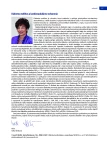Transcutaneous oxymetry – its contribution to diabetic management
Authors:
Ľudovít Gašpar 1; Andrea Komorníková 1; Laura Slezáková 2
Authors‘ workplace:
I. interná klinika LF UK a UNB, Nemocnica Staré Mesto, Bratislava
1; B. Braun Avitum s. r. o., Bratislava
2
Published in:
Forum Diab 2017; 6(3): 135-140
Category:
Topic
Overview
Transcutaneous oxymetry has several uses in angiological practice. It is possible to evaluate the severity of tissue ischemia, evaluate the acute and long-term effects of pharmacological, endovascular, surgical treatment, as well as kinesiotherapy. The method is also helpful in the decision-making process for the amputation height indication and determination and allows estimation of the postoperative course of healing of the amputation stump. The advantage of this method is also the possibility of using it in medial arterial calcification as this does not affect the TcPO2 values. Therefore, transcutaneous oxymetry has a specific role in diagnosing and determining the severity of diabetic foot syndrome, since medial arterial calcification is often present in this syndrome.
Key words:
diabetic foot syndrome, medial arterial calcification, transcutaneous oxymetry
Sources
1. Rathur HM, Boulton AJ. The diabetic foot. Clin Dermatol 2007; 25(1): 109–120.
2. Game FL, Hinchliffe RJ, Apelqvist J et al. A systematic review of interventions to enhance the healing of chronic ulcers of the foot in diabetes. Diabetes Metab Res Rev 2012; 28(Suppl 1): 119–141. Dostupné z DOI: <http://dx.doi.org/10.1002/dmrr.2246>.
3. Wagner FW. The dysvascular foot: a system for diagnosis and treatment. Foot Ankle 1981; 2(2): 64–122.
4. Fife CE, Smart DR, Sheffielde PJ et al. Transcutaneous oximetry in clinical practice: consensus statements from an expert panel based on evidence. Undersea Hyperb Med 2009; 36(1): 43–53.
5. Giacco F, Brownlee M et al. Oxidative stress and diabetic complications. Circ Res 2010; 107(9): 1058–1070. Dostupné z DOI: <http://dx.doi.org/10.1161/CIRCRESAHA.110.223545>.
6. Criqui MH, Ninomiya J. The epidemiology of peripheral arterial disease, . In: Creager M, Dzau VJ, Loscalzo J. Vascular Medicine. Saunders Elsevier: Philadelphia 2006: 223–238. ISBN 978–0721602844.
7. Jeffcoate WJ. Wound healing – a practical algorithm. Diabetes Metab Res Rev 2012; 28 (Suppl 1): 85–88. Dostupné z DOI: <http://dx.doi.org/10.1002/dmrr.2235>.
8. Waniczek D, Kozowicz A, Muc-Wierzgon M et al. Adjunct methods of the standard diabetic foot ulceration therapy. Evid Based Complement Alternat Med 2013; 2013: 243568. Dostupné z DOI: <http://dx.doi.org/10.1155/2013/243568>.
9. Gavorník P. Končatinovocievne ischemické choroby. In: Gavorník P, Hrubiško M, Rozborilová E (eds). Diferenciálna diagnostika kardiovaskulárnych, respiračných a hematologických ochorení. I. Dr. Josef Raabe: Bratislava 2010: B 2.1: 1–92. ISBN 978–80–89182–46–6.
10. Kolluru GK, Bir SC, Kevil CG. Endothelial dysfunction and diabetes: effects on angiogenesis, vascular remodeling, and wound healing. Int J Vasc Med 2012; 2012: 918267. Dostupné z DOI: <http://dx.doi.org/10.1155/2012/918267>.
11. Doherty TM, Fitzpatrick LA, Inoue D et al. Molecular, endocrine, and genetic mechanisms of arterial calcification. Endocr Rev 2004; 25(4): 629–672.
12. De Meijer VE, van´t Sant HP, Spronk S et al. Reference value of transcutaneous oxygen measurement in diabetic patients compared with nondiabetic patients. J Vasc Surg 2008; 48(2): 382–388. Dostupné z DOI: <http://dx.doi.org/10.1016/j.jvs.2008.03.010>.
13. Raposio E, Bertozzi N, Moretti R et al. Laser Doppler flowmetry and transcutaneous oximetry in chronic skin ulcers: a comparative evaluation. Wounds 2017; 29(7): 190–195.
14. Doupis J, Veves A. Classification, diagnosis, and treatment of diabetic foot ulcers. Wounds 2008; 20(5): 117–126.
15. Gašpar Ľ. Transkutánna oxymetria v klinickej praxi. Vydavateľstvo UK: Bratislava 2016. ISBN 978–80–223–4109–7.
16. Nather A, Bee CS, Huak CY et al. Epidemiology of diabetic foot problems and predictive factors for limb loss. J Diabetes Complications 2008; 22(2): 77–82. Dostupné z DOI: <http://dx.doi.org/10.1016/j.jdiacomp.2007.04.004>.
17. Wang Z, Hasan R, Firwana B et al. A systematic review and meta-analysis of tests to predict wound healing in diabetic foot. J Vasc Surg 2016; 63(2 Suppl): 29S-36S. e1–2. Dostupné z DOI: <http://dx.doi.org/10.1016/j.jvs.2015.10.004>.
18. Yazdanpanah L, Nasiri M, Adarvishi S. Literature review on the management of diabetic foot ulcer. World J Diabetes 2015; 6(1): 37–53. Dostupné z DOI: <http://dx.doi.org/10.4239/wjd.v6.i1.37>.
19. Bzdúchová O. Meranie periférnych systolických tlakov dopplerovou metódou. In: Štvrtinová V (ed) et al. Choroby ciev. SAP: Bratislava 2008: 184–185. ISBN 978–80–8095–025–5
20. Resnick HE, Lindsay RS, McDermott MM et al. Relationship of high and low ankle brachial index to all-cause and cardiovascular disease mortality. The Strong Heart Study. Circulation 2004; 109(6): 733–739.
21. Wattanakit K, Folsom AR, Duprez DA et al. Clinical significance of a high ankle-brachial index: Insight from the Atherosclerosis Risk in Communities (ARIC) Study. Atherosclerosis 2007; 190(2): 459–464.
22. O´Hare AM, Katz R, Shlipak MG et al. Mortality and cardiovascular risk across the ankle-arm index spectrum. Results from the Cardiovascular Health Study. Circulation 2006; 113(3): 388–393.
23. Silvestro A, Diehm N, Savolainen H et al. Falsely high ankle-brachial index predicts major amputation in critical limb ischemia. Vasc Med 2006; 11(2): 69–74.
24. Allison MA, Hiatt RW, Hirsch AT et al. A high ankle-brachial index is associated with increased cardiovascular disease morbidity and lower quality of life. J Am Coll Cardiol 2008; 51(13): 1292–1298. Dostupné z DOI: <http://dx.doi.org/10.1016/j.jacc.2007.11.064>.
25. Kmecová D, Kozárová M, Rašiová M et al. Členkovo-brachiálny index ako prediktor kardiovaskulárnej morbidity a mortality. Cardiology Lett 2011; 20(3): 215–220.
26. Štvrtinová V, Šefránek V, Murín J et al. Odporúčania pre diagnostiku a liečbu periférneho artériového ochorenia dolných končatín. Vask Med 2010; 2(Suppl2): 4–18.
Labels
Diabetology Endocrinology Internal medicineArticle was published in
Forum Diabetologicum

2017 Issue 3
Most read in this issue
- Rehabilitation in diabetic patients
- Management of cardiovascular risk in the light of current recommendations
- Diabetes mellitus and cerebrovascular diseases
- Fourier Study: Has it brought little or a lot of good? Or has it just failed to reach exaggerated expectations?
